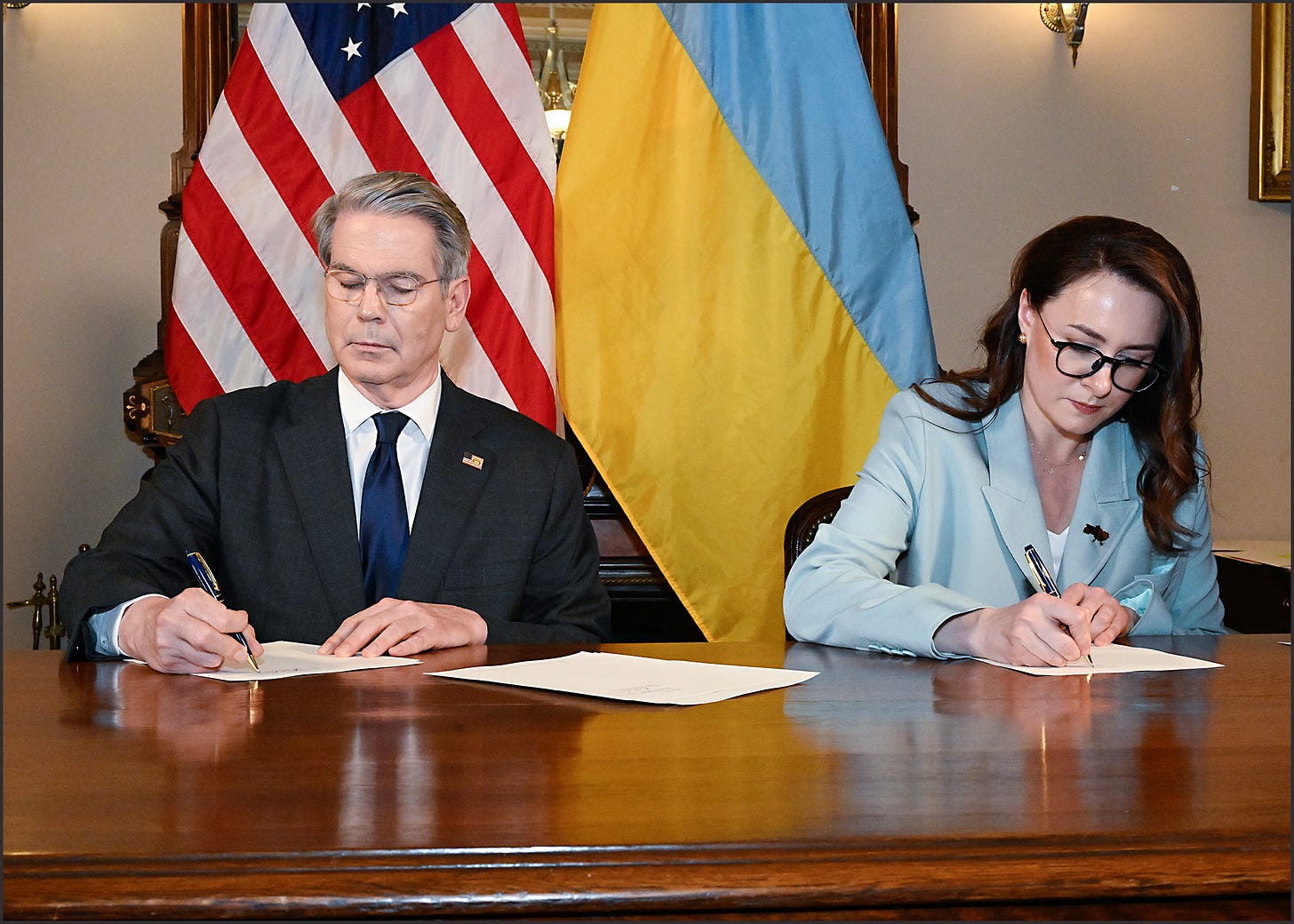Hello and welcome to your weekly briefing on Ukraine.
There is a lot to unpack this week, but refreshingly, almost all of the news falls somewhere between “not bad” and “potentially good” for Ukraine. I don’t remember the last time this happened, so let’s dive right in.
Minerals deal. On Wednesday, the United States and Ukraine finally signed the so-called minerals deal, which had been the subject of dramatic negotiations, leaks, and discussions for months. What many feared would become a colonial method of extortion from generations of Ukrainians turned into something bearable, maybe even potentially beneficial for Ukraine.
The agreement establishes a Reconstruction Investment Fund and gives the US preferential rights to new projects developing Ukraine’s natural resources, including oil, gas, and more than fifty minerals.

Most important is what’s not in the agreement. There are no security guarantees for Ukraine, but there is also no mention of past aid that Trump wanted repaid as debt, nor is there a clause that would endanger Ukraine’s accession to the European Union, mention of America’s control of Ukraine’s infrastructure, or American jurisdiction over the deal. Ukrainian diplomats managed to scrap the worst parts of the deal, while including a clause stating that American contributions to the fund could come in the form of military assistance. This doesn’t mean anything unless Washington acts on it, but it does put that possibility in writing.
As of now, this deal is largely a symbolic political gesture to put the US-Ukraine relationship back on track. It will take billions in foreign investments over many years to see any revenue from Ukraine’s unexplored mineral reserves, which can most likely only happen after a permanent cessation of hostilities.
Trump’s first? The US State Department has approved a possible sale of equipment and services related to F-16 fighter jets to Ukraine worth around $310 million. The Pentagon said the sale will include personnel training and maintenance support, among other things.
If the sale goes through, it will be the first time the US has provided Ukraine with military support since Trump took office. Even though this support comes with an invoice, it will show that Trump is at least open to selling weapons and equipment to Ukraine, which was never self-evident.
Victory Day truce. The Kremlin announced a three-day truce from midnight on May 8 until midnight on May 11, planning to hold a pompous military parade in Moscow to mark the 80th anniversary of the end of World War II in Europe. Zelensky slammed the idea, calling for an unconditional 30-day ceasefire instead.
Such short ceasefire proposals put Ukraine in an impossible position. By rejecting it, Ukraine risks being portrayed as a hindrance to the peace process. But by agreeing, Ukraine allows Russia to gain a tactical advantage on the battlefield. Just consider Russia’s “Eastern truce” two weeks ago. There were no missile or drone attacks against big cities, but the front line was far from quiet. Russia either continued assaulting Ukrainian positions or conveniently relocated its forces without fear of Ukrainian fire. Russia is the only one benefiting from this arrangement, so it makes sense why Ukraine rejected it this time.
Kremlin’s miscalculation? This week was a bad one for Russia. The Washington Post’s Catherine Belton reported that “nervousness is rising among the Russian elite” after the signing of the minerals deal with Ukraine, which Treasury Secretary Scott Bessent hailed as a sign to the “Russian leadership that there is no daylight between the Ukrainian people and the American people”.
The 3-day truce offer didn’t help the Kremlin either. It was meant to portray Russia as a peace-seeking party, except this time, even Trump isn’t buying it. “The president has made it clear he wants to see a permanent ceasefire,” White House spokesperson Caroline Leavitt told reporters on Monday. Trump’s Ukraine envoy, Keith Kellogg, called the offer “absurd”.
I am honestly a bit perplexed by Russia’s inability to broker a deal with the US in recent weeks. Trump offered Putin nearly everything he wanted, including concessions that were once unthinkable, and Putin still walked away. This week, the Kremlin once again reiterated its maximalist demands, including international recognition of Russian control of not only Crimea but the entirety of Donetsk, Luhansk, Kherson, and Zaporizhzhia oblasts, which, I remind you, Russia doesn’t fully control.
I can’t imagine the White House ever agreeing to this, so what is Putin counting on here?
Other stories I’m following…
From the Wall Street Journal: The Russian Military Moves That Have Europe on Edge.
And another one from WSJ: Trump Ally Lindsey Graham Pushes Russia Crackdown
From High North News: Russia’s Arctic ‘Yamal LNG’ Gas Plant Saw a Record 287 Cargo Loadings in 2024
Cheers,
— Yours Ukrainian




